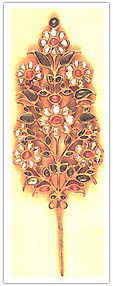|
|
||||||||||||||||||||||||||||||||||||||
| About
eIndiaTourism.com |
|||||||||||||||||||||||||||||||||||||||
|
|
||||||||||||||||||||||||||||||||||||||
| About
eIndiaTourism.com |
|||||||||||||||||||||||||||||||||||||||
 Vanity,
a love of opulence and deep aesthetic sense gave the Rajas and Ranas of
Rajasthan a great fondness for jewellery. The men were as elaborately and
dazzling dressed as the women, with jewelry that often rivaled that of
their wives. It was a status symbol and a portable display of wealth, and
consequently, power Turban jewellery was the prerogative of king, his
close family or the members of his entourage (including his horse).
Vanity,
a love of opulence and deep aesthetic sense gave the Rajas and Ranas of
Rajasthan a great fondness for jewellery. The men were as elaborately and
dazzling dressed as the women, with jewelry that often rivaled that of
their wives. It was a status symbol and a portable display of wealth, and
consequently, power Turban jewellery was the prerogative of king, his
close family or the members of his entourage (including his horse). 